Design
絵文様
Animal Design
Sweetfish
The sweetfish is a freshwater fish that grows by eating diatoms attached to rocks on the riverbed. They spawn in the middle reaches of rivers in the fall, and when they are young they go down to the sea to overwinter, and in early spring they go up the river to live in clear streams. Because their lifespan is usually one year, they are called “Year Fish” and some of them are also known as Etsunen sweetfish. Sweetfish can’t survive in murky water, so the fact that sweetfish live there is also a barometer of water quality. Sweetfish is a seasonal fish that heralds the arrival of summer, and is also called “Fragrant Fish” because its meat is fragrant. There is also a legend that Empress Jingu fished sweetfish and used fortune telling to pray for victory in battle.
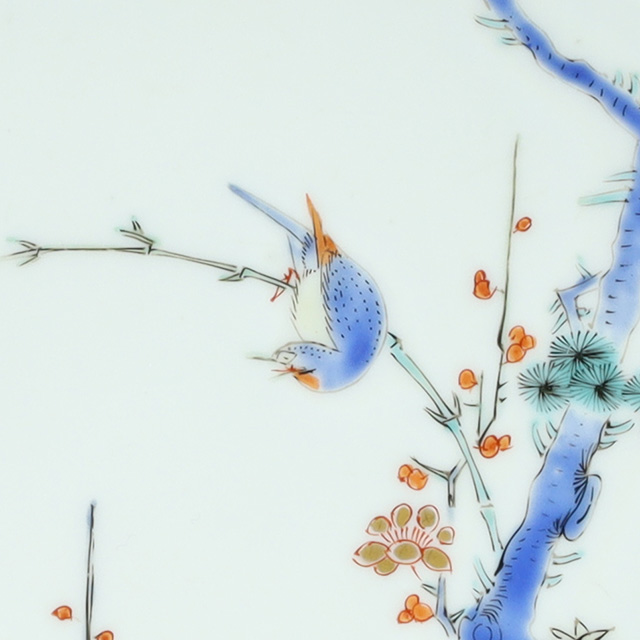
Nightingale
The nightingale is an auspicious bird that heralds spring, with nicknames such as spring bird, spring warning bird, and spring bird. In the summer, they breed in bush forests in mountainous areas, and in the winter, they migrate to lowlands and appear in urban areas. It has been prized as a pet bird for a long time because of its singing. The sight of a nightingale perched on a plum tree is beautiful, and the phrase “a nightingale on a plum” is a perfect metaphor for the combination. It is counted as one of japan’s three songbirds and is the prefectural bird of yamanashi and fukuoka prefectures.

Rabbit
It is said that the rabbit’s jumping appearance brings it leaps, its fertility brings prosperity, and its habitation on the moon brings luck. The moon and rabbit have been familiar since ancient times, and have been known by nicknames such as “Moon Rabbit”. In china, rabbits and toads who create the elixir of immortality live on the moon, and in japan, rabbits make mochi pounding on the moon. The rabbit in the waves is based on chikubu island in lake biwa, and is associated with the noh song “Chikubu Island,” but it is also thought to reflect the image of inaba’s white rabbit, which tried to trick the crocodile and shark into crossing the ocean. There is also a legend that when Daio-Kokushi’s ship encountered a storm while returning home after studying abroad in the song dynasty, a white rabbit ran across the waves and opened a channel to save the day. The rabbit in the waves was known as the “God of Fire Protection” and had a special faith among potters who worked with fire. Even in early-imari, a moon rabbit design similar to the kosometsuke of the ming dynasty can be seen, and it is assumed that it was influenced by the kosometsuke. One of its characteristics is that kosometsuke rabbits have short ears, while early-imari rabbits have long ears and are cute.

Horse
In japan, horse is regarded as “God’s Vehicle” and is considered sacred animal. When offering prayers to the gods at shrines, a live horse was used to be offered as an offering, but instead of the expensive horse, people started offering a picture of a horse on a board. This is considered to be the beginning of votive picture. Horses have supported people’s lives since ancient times, plowing fields, carrying heavy loads, and serving as inseparable partners. Sometimes it has come to have a meaning as a lucky charm that protects lives on the battlefield and brings “Victory”, and it is also said to be necessary for warriors to achieve great achievements, as the word “Ride on a Winning Horse” means to arrive at an advantageous side.
Shrimp
The shrimp live in water bodies such as the sea, lakes, rivers, etc. The figure with long whisker like antennae attached to its head, curled at the waist, and jumping vigorously has long been likened to an old man who is energetic even when bent at the waist, and has been considered a symbol of eternal youth and longevity in japan. In samurai society, the figure covered in hard shell was considered a symbol of a brave military commander wearing armor. In china, the abdomen bends freely and has a strong bouncing force, which symbolizes “things going smoothly and good luck”.

Crab
The crab is considered a symbol of “60th birthday”. “Chrysanthemum and Crab”, which are auspicious for the 60th birthday, represent kako(chrysanthemum = flower, crab = shell). Also, in china, the crab has the meaning of resisting authority and going sideways(one’s own way).
Turtle
The turtle, along with the crane, has long been considered a symbol of longevity and auspiciousness, and crane and turtle was depicted along with pine, bamboo, and plum on mt. hourai, which is said to be a symbol of chinese immortality. It is said that “turtle live for ten thousand years,” and when they reach a thousand years old, they acquire a spirit and learn about good and bad fortune. In ancient china, it was revered as one of the “Four Spirits” along with the Qilin, Phoenix, and Doragon, and it was said that the “Four Gods” of the Blue Dragon, White Tiger, Vermilion Bird, and Black Tortoise protect the north, south, east, and west.

Kingfisher
The kingfisher is a small bird that lives near water and is characterized by its bright light blue body color and long beak. Due to its beautiful appearance, it is also called the “Gem of the Mountain Stream” or “The Blue Jewel”. The light blue color of its back peeking out from between its wings is so vivid that it looks green. The gemstone “Jade” is named after the color of this bird’s plumage.
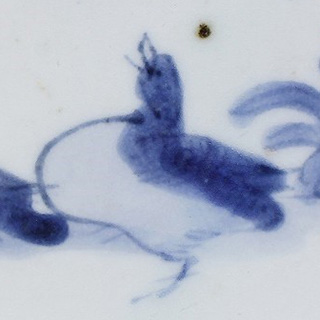
Goose
Geese come in the fall and return in the spring, but since the early modern period, the name has come to refer to the geese in the fall. The ancient people loved the rows of geese flying in an orderly manner in the autumn sky, and they called them “Two Season Birds” in honor of the spring geese that left behind the flowers. Another characteristic is that they line up horizontally or in a v-shape when flying. The reed and goose design, which were drawn together with reed, were also frequently used.
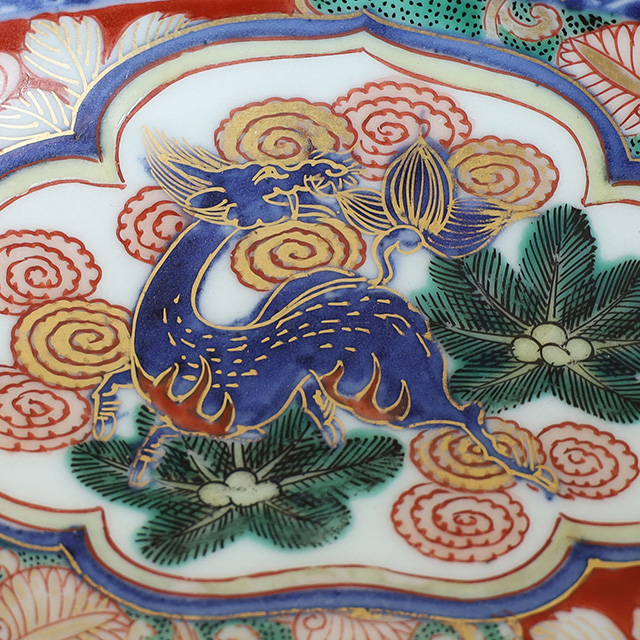
Qilin
The qilin is an imaginary auspicious beast that is said to appear when a saint enacts good governance. In ancient china, it was revered as one of the “Four Spirits” along with Phoenix, Turtle, and Doragon. Its body is a deer, its tail is a cow, its hooves are a horse, its forehead is similar to a dragon, and there is a single horn on its head. The hair on its back is five colors and its body is yellow. It is a symbol of good luck that brings happiness and prosperity.

Peacock
In china, peacock have been placed together with peony as auspicious birds. Its gorgeous appearance is considered a symbol of wealth, and its strong vitality and fertility mean that it will bring prosperity to descendants. It has been revered as a beneficial bird that wards off evil spirits as it likes to feed on pests such as scorpion and poisonous snake.
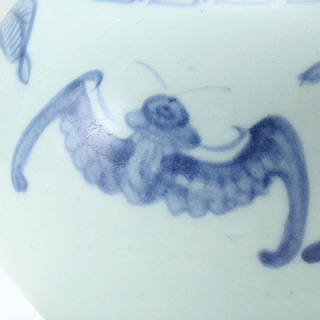
蝙蝠
蝙蝠の語源は蚊をよく捕食する事から「蚊屠り」と呼ばれたのが由来とされています。視覚は鈍く、声帯から超音波を発して反響を聞きながら障害物との距離を計ります。中国では蝙蝠の「蝠」が「福」と同音である事から吉祥を意味し、「五羽の蝙蝠」は「五福」と呼ばれ、長寿、富貴、栄達、健康、子孫繁栄の象徴とされました。蝙蝠の文様が単独で用いられる事は極めて少なく、李朝では壽字や蓮文様と組み合わされたりして用いられています。

Heron
The heron bends its neck when it flies, and during the breeding season the feathers on its head grow long backwards. In china, the white heron was loved for its beauty and graceful appearance, and like the lotus, it was a favorite symbol of a noble character that would not be submerged in mud. The heron on the lotus pond is an allegory for “One Way Career Success(one successive career success after passing the national examination)”, and was often depicted in paintings and crafts from the song dynasty onwards. It is assumed that the white heron depicted on hizen porcelain is not so much a symbol of nobility, but rather a sense of familiarity found in familiar waterside landscapes.

鹿
鹿は神の使いとして神社に飼われる事もあり、角は雄のみにあって毎年生え変わります。中国では1000年で「蒼鹿」、1500年で「白鹿」、2000年で「玄鹿」になるとの伝説があり、長寿の仙獣とされています。寿老人には玄鹿を伴う表現が多いです。又、福禄寿の「禄」と同音同声である為、文字の上からも長寿の象徴とされています。明・清時代の磁器には多数の鹿が描かれた「百鹿文」が知られています。日本においては平安時代に鹿と紅葉を組み合わせる文様が生まれ、後に和様意匠として長く用いられる事になりました。鹿は餌を見つけると仲間を呼んで一緒に食べ、 「鹿鳴」には賓客を招いて宴会をするという意味があります。
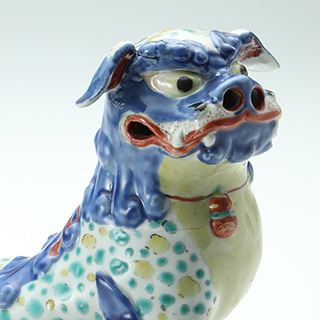
Lion
The lion is a tropical animal. In ancient times, it was also called “Karajishi” to distinguish it from boar and deer. Since this animal was not found in japan, learned about it from paintings and designs that were brought over from china. For this reason, the lion depicted as design is quite different from actual lion. Lion is said to have the power to ward off evil, and famous examples include the “Karajishi-Botan”, which combines a lion with a peony, and the “Tamatori-Jishi”, which shows a lion playing with a jewel. “Peony and Lion” refers to a good combination.
雀
雀は一年を通して見られる愛らしい鳥です。古来、厄をついばむ鳥として、子孫繁栄や家内安全の象徴とされてきました。文様としては平安時代から見られ、竹に雀、稲穂をついばむ雀、冬の寒さに羽毛をふっくらと膨らませた福良雀等、日本人特有の細やかな自然観察で意匠化されています。

Butterfly
Butterfly designs were established as a design in the nara period, and were also used in court nobles’ costumes and furniture in the heian period. As it changes from egg to larva and pupa, and eventually transforms into a beautiful butterfly, it is associated with a woman’s life, and is a favorite design for long sleeved kimonos, wishing for healthy growth. The sight of them flying high into the sky is a favorite among samurai families as a symbol of career advancement, immortality, and resurrection, and the sight of them flying harmoniously together during the spawning season is a symbol of marital harmony. In china, it is considered an auspicious design that means longevity.

Swallow
Swallows are migratory birds that cross the ocean from southeast asia to japan when the weather gets warmer in the spring. To protect themselves from predators such as crows and snakes, they build nests in places where people often come and go, such as under the eaves of houses. Summer is the time for swallows to raise their young, and as they raise their young in pairs, they have the meaning of having many children, safe childbirth, and good luck with marriage. Since ancient times, it has been said that the bird brings good fortune, and that “The house where the swallow nests will prosper”. It was loved by farmers as a beneficial bird that ate pests.

Crane
The cranes, along with turtles, were considered symbols of longevity and were revered as auspicious birds. They live in groups in swamps, plains, and beaches, nesting and laying eggs on the ground. It is also a symbol of marital harmony because the male and female act together and live together throughout their lives. The pine twig in its mouth is a bird that flies from far away with plant seeds and twigs in its mouth. It is thought to be a messenger of the god of grace, and this idea is rooted in the cultures of india, persia, and the orient. It was introduced to china and then to japan. “Crane clouds” drawn with clouds are also widely used as designs.
闘鶏
闘鶏とは雄鶏を闘わせて勝負を競う行事で「鶏合」ともいい、「英雄闘志」の吉祥文様です。唐の玄宗が乙酉生まれだった為、清明節に好んで催された故事が由来とされています。日本では中国文化の伝来と共に奈良時代以前から行われていたと推測されますが、最も古い記録は8世紀前半に編纂された『日本書紀』であり、平安時代の宮中で春先の陰暦3月3日の行事として流行しました。平安後期には庶民間にも広く親しまれ、江戸時代には賭博の対象とされる事が多くなった為、幕府は幾度か禁止令を発し、明治時代には法令で禁止される地域もありました。
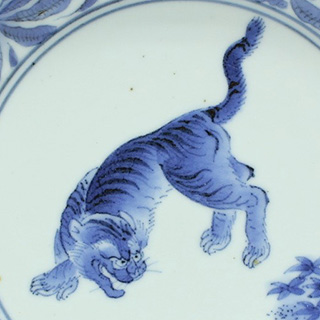
虎
虎はシベリアからアジアに広く分布し、多くは単独で森林や水辺に生息します。竹林に潜む「竹虎」、龍と共に描かれた「龍虎」等も意匠として広く用いられています。
鼠
鼠の殆どは夜行性で人間が寝ている間に食料等を食べたりするので、「寝盗み」が転じて「ねずみ」という名称が付いたと云われます。一生伸び続ける特徴的な門歯を持つ為、常に何か硬い物をかじって前歯をすり減らす習性があります。繁殖力の強さから子孫繁栄や五穀豊穣の象徴ともされ、白鼠(大黒鼠)は福をもたらす「大黒天の使い」として知られています。大黒鼠は「大根食う鼠」と音が似ている事から縁起の良い取り合わせとされます。

Phoenix
The phoenix is an imaginary sacred bird that dwells in paulownia trees, eats bamboo nuts, and drinks spring water. In ancient china, it was revered as one of the “Four Spirits” along with Qilin, Turtle, and Doragon. It is said to appear as an auspicious sign of the birth of the holy heavenly son, with the front half of its body resembling that of a qilin, its back half a deer, its neck a snake, its tail a fish, its back a turtle, its nod a swallow, its beak a chicken, and its wings. Like a peacock, it is said to have five colors and a noble voice that matches the five tones. It is considered a symbol of marital harmony and is often depicted with paulownia and peony. In china, the dragon is known as the symbol of the “Emperor” and the phoenix is the symbol of the “Empress”.
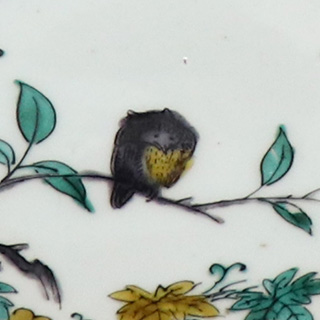
木菟
木菟には羽角という耳のように突出した羽毛があり、梟には一部を除いてありませんが、何れもフクロウ科に属する同じ仲間で分類学上の区別はありません。梟は古代ギリシャでは女神アテナの従者であり、「森の賢者」と称される知恵の象徴とされています。日本において「不苦労=苦労しない」、「福来郎、福籠=福が訪れる」、「福老、富来老=豊かに年を取る」、「福路=旅の安全、人生の幸福」等のゴロ合わせから、幸福を招くとも伝えられます。
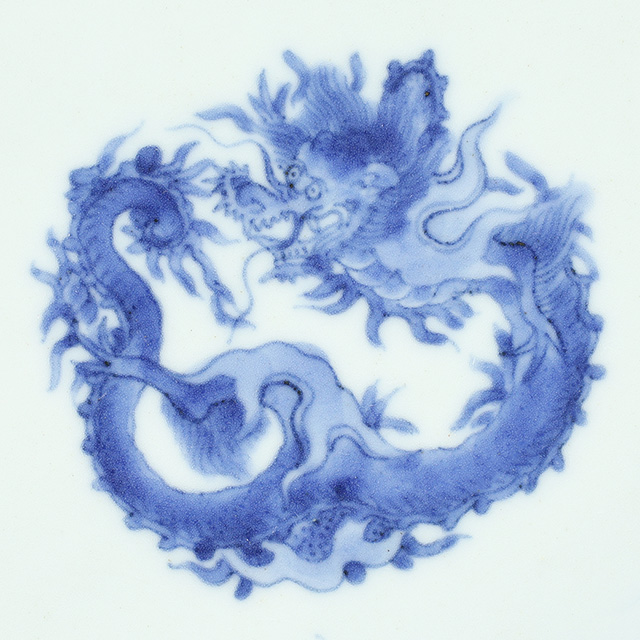
Doragon
The dragon is an imaginary creature that lives in water, flies in the sky, and creates clouds and summons rain. In ancient china, it was revered as one of the “Four Spirits” along with Qilin, Phoenix, and Turtle. In china, the dragon is known as the symbol of the “Emperor” and the phoenix is the symbol of the “Empress”, and it has become an important decorative design in korea and japan. In 1297, it was decided that the dragon claws used by ordinary people should have four claws, and in 1314, the yuan dynasty decided to use the “Five Claws and Two Horns” dragon as the symbolic design of the emperor and court. The ming and qing dynasties also inherited this system, and it was used in the official kiln of jingdezhen. The idea of five clawed dragon did not enter japan. It is said that the dragon was drawn in a round design, reflecting the desire of the common people to be a wise ruler who could rule the world in a circle.
植物文様
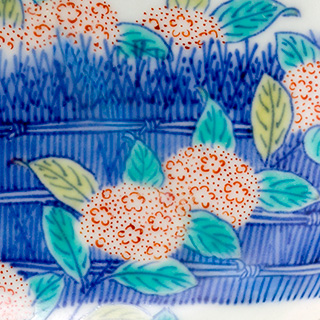
紫陽花
紫陽花は白、青、赤、紫等、様々な色がありますが、土が酸性だと青色、アルカリ性だとピンク色の紫陽花が咲きます。順々に色彩が変化するところから「七変化」の名称も知られています。語源は「あづさい‐青い花が集まって咲く‐」で、「あづ(集まる)」+「さあい(真藍)」に由来しています。花色の変化から「移り気、心変わり」等の花言葉もあります。長崎市花にも指定されています。

梅
梅は早春、葉に先立って色彩豊かに花を開きます。花は五弁で色は白、紅、薄紅等があり、身近でおめでたい植物として好まれました。香気が高く、夜に香るともいわれます。日本にも奈良時代迄には中国から伝えられたとされており、平安時代以降は特に香を賞で詩歌に詠まれました。江戸時代以降は品種改良が進み、江戸中期頃から果実生産も盛んになりました。果実は梅干しや梅漬けとし、木材は器物として使用されます。その美しさを高潔な花として君子に例えた「四君子(菊、蘭、竹、梅)」にも含まれており、君子とは徳が高くて品位の備わった人物を指します。又、「三友(松、竹、梅)」、「五友(菊、蘭、竹、梅、蓮)」の一つとしても知られており、文様に知られる「梅に鶯」とは取り合わせの良い事の喩えとされています。
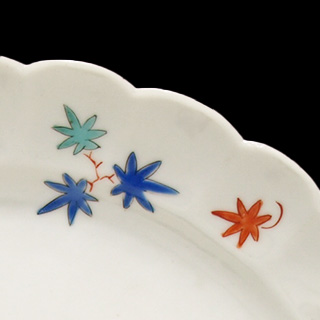
楓
楓の語源は葉が蛙の手を広げた形に似ている「蛙手(かへるで)」の転とされています。紅葉は秋に木の葉が紅変する事を指し、美しい楓の紅葉がそのまま植物名になりました。古くから秋の風物詩として欠かせません。紅葉はカナダの国章にも指定されています。
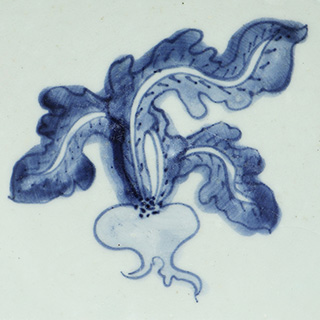
蕪
蕪は寒い冬の時期にも沢山の葉を付け、大きな実に成長する生命力の象徴です。別名をカブ、カブラナ、スズナといいます。「春の七草」の一つであり、1月7日(人日の節句)に食べて、邪気払い、無病息災を祈願します。かぶ(株)が上がるから幸運とされ、かぶら・かしら(頭)は立身出世を意味する事から事業を始める縁起物ともされます。

Chrysanthemum
The chrysanthemum was introduced from china as a medicinal herb during the nara period. In the heian period, during the chrysanthemum festival(9th day of the 9th month of the lunar calendar), a “Chrysanthemum Viewing Banquet” was held in the imperial court to pray for longevity by drinking chrysanthemum sake, and songs about chrysanthemums were composed. The story of the noh play “Kikujido” is that he became immortal by drinking the dew of a chrysanthemum, and kikusui was associated with good luck for longevity. This was appreciated by successive emperors and was incorporated into the imperial family crest(16 heavy valves). It is also included in the “Four Gentlemen(Chrysanthemum, Orchid, Bamboo, Plum)”, whose beauty is compared to a gentleman as a noble flower, and a gentleman refers to a person with high virtue and dignity. It is also one of the “Five Friends(Chrysanthemum, Orchid, Bamboo, Plum, Lotus)” and “Three Fragrances (Chrysanthemum, Orchid, Daffodil)”. “Kikusui” is a japanese favorite design that depicts chrysanthemums floating in flowing water, and is also famous as the family emblem of Masashige Kusunoki, a military commander during the nanbokucho period. “Kikutori”, which is representative of kodaiji makie, is based on a chinese legend in which auspicious birds gather in paulownia trees.
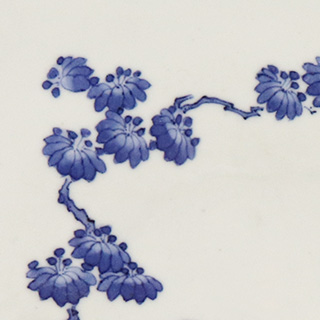
桐
桐は五月頃に芳香ある淡紫色の鐘状花が円錐状に集まって開きます。材は軽軟の色白で調湿性や耐火性に優れて防虫効果があり、軽くて加工しやすい事から琴、箪笥、家具材、下駄、箱等に用いられます。古来より日本では女児が産まれると桐を植え、婚礼時には娘の幸せを願い、嫁入り道具として桐箪笥を誂えるという風習がありました。葉と花を組み合わせた形は吉祥文様であり、嘗ては「十六弁の菊花文」と同様に「五七の桐文」は皇室の許可なく使用する事は禁止され、後に豊臣秀吉が「五三の桐文」を織田信長から拝領し、更に天皇家から「豊臣」姓と共に「五七の桐文」を賜りました。秀吉はその権勢を誇示する為に衣装、家具、襖等に使用して「太閤桐」と名付けて愛用しました。
芥子
芥子には多くの種類があり、日本でよく目にするのは葉が薊に似ている薊芥子、「虞美人草」や「ポピー」とも呼ばれる雛罌粟、茎や葉に固い毛が生えている鬼芥子等の園芸種です。食用としては種子を和菓子やアンパンの表面にまぶしたり、七味唐辛子の原料、金平糖の芯、小鳥の餌、油の抽出に使う等、幅広く利用されてきました。「オピウムポピー」と呼ばれる系統はアヘンの原料となる事から日本での栽培は禁止されており、毒(麻薬)にも薬(鎮痛剤、睡眠薬)ともなります。

Pomegranate
The pomegranate was introduced to japan during the heian period as fruit trees and ornamentals. Bright red flowers open around june, and the fruit ripens in autumn, taking on a large spherical shape. The fruit skin is yellowish red with black spots, and when ripe, it splits to expose some of the many seeds inside. In china, it is an auspicious design that means abundance of children, and in japan it is also considered an auspicious fruit as a symbol of Kishimojin.
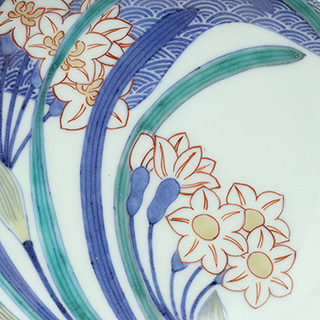
水仙
水仙はシルクロードを経て唐時代に中国へ伝わり、日本には平安時代に齎されました。語源は「水の仙人」を意味する中国古典に由来します。春に先駆けて清楚で香しい花を咲かせる水仙は新春の瑞兆花ともされ、雪中に毅然として咲く「雪中花」の名でも知られています。三香(菊、蘭、水仙)の一つとされ、福井県越前海岸の群生(越前水仙)は有名で福井県花に指定されています。

Bamboo
Bamboo has long been considered an auspicious plant because it grows straight toward the sky and has the vitality to remain green even in winter without dying. The origin of the word is that it grows quickly and increases in length, and it is also considered a symbol of the prosperity of descendants. It has the meaning of strength, purity, moderation, immortality, and longevity. It is included in the four gentlemen(chrysanthemum, orchid, bamboo, plum), whose beauty is compared to a noble flower, as well as the san-yu(pine, bamboo, plum), and the go-yu(chrysanthemum, orchid, bamboo, plum, lotus). Bamboo best reflects japanese tradition and aesthetic sense.

Azalea
The azalea is widely distributed mainly in asia and is the national flower of nepal. It is one of the most popular plants in japan, and has been cultivated since ancient times to the extent that it is mentioned in the manyoshu. The oldest trees are estimated to be over 800 and even 1,000 years old. The azalea comes from the fact that it is “beautiful enough to stop the person who sees it”.

Camellia
Since the camellia is an evergreen tree, it symbolizes longevity. It is said to be a sacred tree that is native to japan and has magical powers since ancient times, and the canes and mallets made from camellia, as well as the ashes and smoke created by burning the branches and leaves, were believed to have the power to ward off misfortune and evil spirits. In the tea ceremony, it was an inseparable winter flower, and in daily life it was also used as an oil, cosmetics, and medicine. The red and white colors are suitable for celebratory occasions, and are also popular as kimono design that exude elegance and glamor.

Lotus
In buddhism, the lotus is a sacred flower that blooms in the pure land. The beautiful flower that grow in pond and swamp and bloom from the filthy muddy water is considered to be a symbol of buddha’s wisdom(enlightenment)and compassion. After the flower fall, the flower receptacle becomes a honeycomb, so in japan it was called “Honeycomb(Hachisu)”, but it was later corrupted to “Lotus(Hasu)”. It is also one of the “Five Friends(Chrysanthemum, Orchid, Bamboo, Plum, Lotus)”.
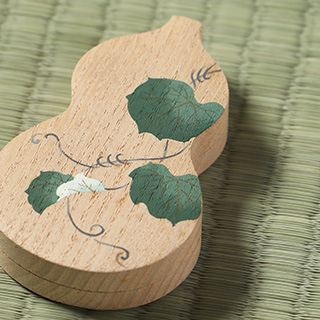
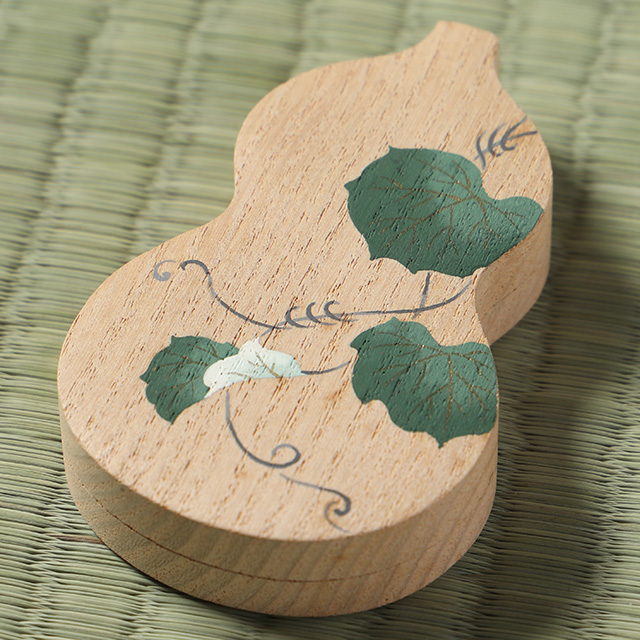
Gourd
Gourd have been considered lucky charm since ancient times and have been widely used as talismans to ward off evil and bring good fortune. When three are together it is said to mean “Three Beats” and when six are together it is said to mean “Sound Health”. As the vines grow and bear many fruits, it also has the meaning of “Prosperous Descendants”. It is said to have the effect of “Basatsu”, which activates the circulation of energy in the house and absorbs bad energy, weakening it.

Peony
The peony was introduced from china during the nara period. It was originally thought to have medicinal properties(pain relief, anti inflammation, blood purification), but since the tang dynasty, it has been named the “King of Hundred Flowers” because it is more elegant and luxurious than any other flower. It has been the subject of poetry, literature, and paintings since ancient times, and in the heian period it began to be used as a design on costumes. “Peony and Lion” refers to a metaphor that is a good combination. The peony arranged in celadon is the best combination.
その他の文様
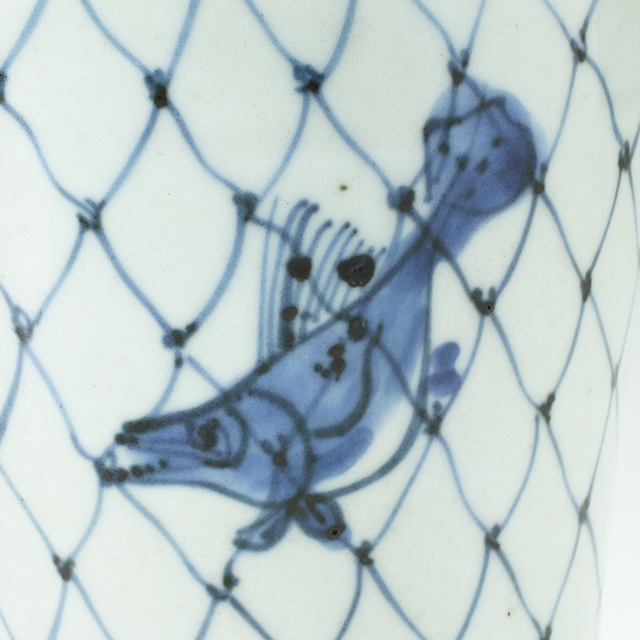
Mesh and Fish
The mesh has the meaning of making a wish come true(entanglement). Fish is an allegory for abundance, and the auspicious design of the mesh and fish is “To Grab Abundance with One Swoop.”
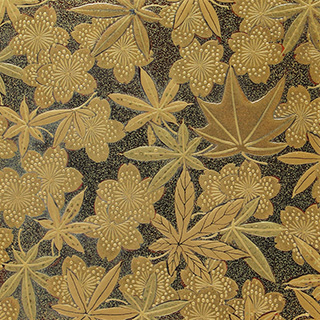
雲錦
雲錦とは満開の桜を白雲に(昔の桜は白色が主流)、鮮やかに色付いた紅葉を錦織に見立てた春秋の季節感を共に満喫できる日本的意匠です。
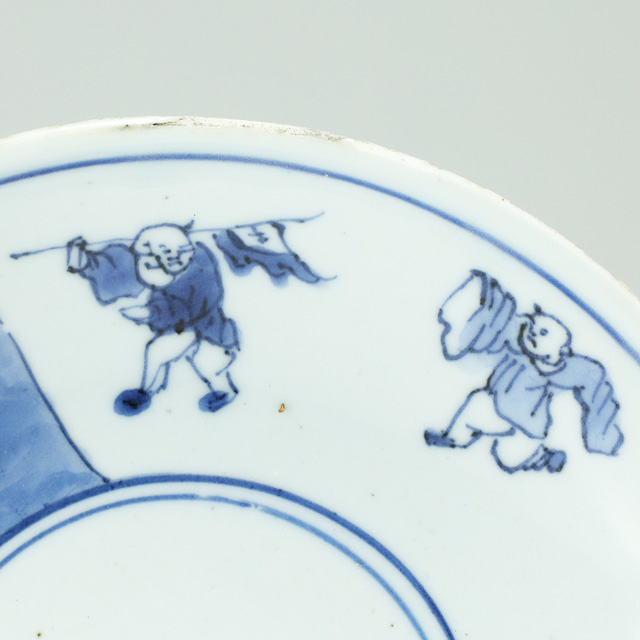
Karako(Chinese Boy)
The karako is a child with chinese style hair and clothing. Karako design was established from the desire to be blessed with children, the safety of the family, and the prosperity of descendants. This design is often seen in kosometsuke, and is strongly inherited by hirado ware.
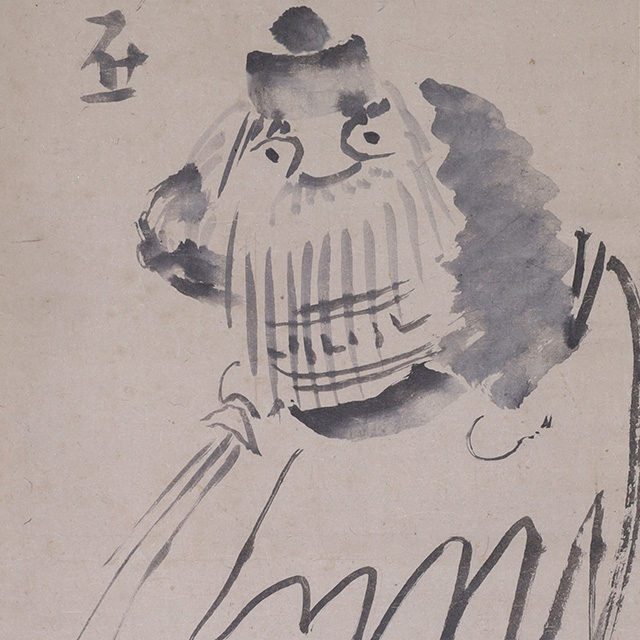
Zhong Kui
Emperor Xuanzong lays in bed with an illness(malaria)and has a dream while suffering from a high fever. A small demon was playing tricks in the palace, but a large demon appeared and easily captured and ate the little demon. Xuanzong asked the big demon about its true identity. “I am Zhong Kui from shonan prefecture. During the Butoku era(618-626), I took the imperial examination to become a government official, but I failed, and I was ashamed of it and committed suicide in the imperial court. However, I have come to repay Emperor Gaozu for his generous burial.” he says. When Xuanzong woke up from his dream, his illness had been cured, and he had Wu Daoxuan draw a picture of Zhong Kui. The brave figure with huge eyes and a beard, sword drawn, and grabbing a small demon was exactly what Xuanzong had seen in his dreams. In order to exorcise and quell evil spirits, on new year’s eve(a day when it was believed that many demons would come out of their graves), the custom of posting a picture of Zhong Kui in each house to ward off demons became widespread. From the end of the ming dynasty to the beginning of the qing dynasty, the custom of displaying Zhong Kui pictures in homes during the dragon boat festival to ward off evil spirits arose. In japan, it is also popular as a god of protection against evil spirits, good health, and academic success.
壷々
壷々とは三千家家元の替紋として知られる意匠です。京都・伏見稲荷大社に信仰の厚かった元伯宗旦が、初午の日に境内で売られていた土産物の田宝(伝法)を紋に好み替えたもので、三千家個々に組み方が異なっています。田宝とは底が平らで中に膨らみのある口が狭い土器です。粗塩を入れて火中に投じて焼塩(精製塩)を作るのに使用されました。小振りのものは幾つかを掌に入れて転がすと「ツボツボ」という音を発する事から、「壷々」とも呼ばれて子供用の玩具とされました。名称の由来は大阪市此花区伝法町で作られたとする説が知られています。
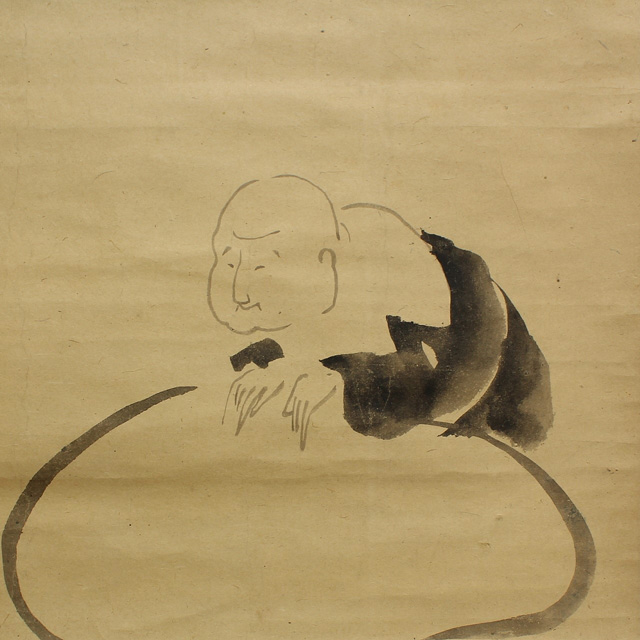
布袋
布袋は唐時代末期に実在したとされる禅僧です。名を契此、号を長汀子といいます。杖と大きな布袋を持った太鼓腹の容貌は福々しく、施しを求めて市中を歩きました。吉凶や天気を占い当てたという逸話も伝えられており、中国では弥勒の化身、日本では七福神の一尊として信仰されています。富貴繁栄や幸福の象徴とされており、所持品の袋は「堪忍袋」ともみなされるようになりました。その円満の相は水墨画の好画題とされています。各地を行脚し、訪れた先々でたくさんの貧しい人々に出会って救いの手を差し伸べ、袋の中から必要な物を与えました。返礼に頂いた物を袋の中に入れ、行脚の旅に出る。これを繰り返している間に袋はどんどん大きくなっていきました。布袋さんの袋は感謝と慈悲の心で溢れています。


